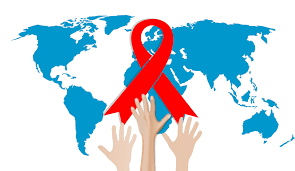Kiran Shaheen
One of the most difficult medical issues of our day is the Acquired Immunodeficiency Syndrome (AIDS). Studies in the fields of epidemiology, serology, immunology, and virology have all clearly shown that the human immunodeficiency virus (HIV) is the primary cause of this recently identified deadly illness.The last obvious event in the series of events that starts when the Human Immunodeficiency Virus (HIV) enters the host is Acquired Immunodeficiency Syndrome (AIDS). Sexual contact is the most prevalent way that HIV is spread, and in many parts of the world, this method is now accepted as the cause of the epidemic.
HIV cases were first discovered in Pakistan through blood transfusions and high-risk populations like drug users. The quick spread of the virus inside families especially between husbands and spouses and their offspring emphasized the possibility of heterosexual transmission spreading widely. The sociocultural background of Pakistan has a big impact on HIV transmission. Certain groups are vulnerable due to factors including migration, urbanisation, and conventional gender roles. Those who inject drugs (IDUs), work in commercial sex (especially Hijras), and have more than one sexual partner are more vulnerable.
Although blood transfusions and international travel were frequently associated with the first HIV diagnoses, the disease is becoming more and more localised. HIV clusters are starting to form among IDUs, particularly in places like Larkana, which emphasises how quickly and densely the epidemic is spreading. HIV transmission is fuelled by IDUs’ continued engagement in high-risk behaviours. Pakistan’s efforts to combat the HIV/AIDS epidemic are beset with serious difficulties. Stigma, cultural hurdles, and a lack of resources impede prevention and treatment initiatives. The effects of harm reduction initiatives for IDUs have been inconsistent, highlighting the necessity for all-encompassing strategies that incorporate economic possibilities and rehabilitation.It seems that most HIV/AIDS patients are from low-income and/or undereducated backgrounds. Their ignorance of the virus or safe sex practices may have contributed to their acquisition of HIV.
HIV and sexually transmitted infections disproportionately impact hijras, a marginalised minority of transgender people. Research indicates that although the prevalence of HIV is still low, this community has high rates of syphilis. Hijra-specific preventive initiatives are essential to stopping the spread of these illnesses. Due to insufficient screening procedures, the possibility of HIV infection through blood transfusions is still a worry in Pakistan. To stop new infections, blood safety protocols must be strengthened and voluntary blood donation must be encouraged.
Even though the government has started HIV/AIDS prevention initiatives, the epidemic is still rising and calls for coordinated action. To provide preventative, treatment, and care services that are successful, cooperation between government agencies, non-governmental organisations, and international organisations is necessary. It is impossible to assess the
National AIDS Programme’s efficacy in reducing HIV/AIDS cases and increasing public awareness of prevention. A number of issues still need to be addressed, such as improved coordination between the public and private sectors and health and community organisations, as well as the provision of more funding and other infrastructure to support AIDS initiatives. The construction of several screening and monitoring centres as well as public awareness campaigns about HIV/AIDS through media outlets like television and the popular press, however, allow one to assess the advantages of the existing policy.
In Pakistan, giving blood without conducting the necessary screening is a frequent practice. A study on blood transfusion procedures in Pakistan found that while circumstances in private hospitals are depressing, just five to ten percent of blood transfusions in government hospitals are appropriately examined. There isn’t any legislation in place right now that addresses safe blood transfusion. In affluent nations, there is a well-functioning blood banking system complete with all necessary amenities.Nevertheless, Pakistan’s inadequate infrastructure and, when it exists, subpar resources for blood transfusion screening make it challenging to establish comparable facilities. A further issue with blood donations by HIV-positive donors is the “Mafia-like” professional blood system that exists, and the fact that many blood donors are drug addicts.
HIV/AIDS prevention and treatment plans use a variety of techniques. Programs for harm reduction are important, and enhancing results requires assessing how well various harm reduction strategies work. The foundation of HIV treatment is antiretroviral medication (ART), and talking about ART’s accessibility and availability in Pakistan helps highlight the problems and advancements that the field is now facing. Furthermore, investigating the possibility of alternative preventive measures, such as pre-exposure prophylaxis (PrEP), emphasises critical tactics in stopping the spread of HIV.
Pakistan’s battle against HIV/AIDS is reaching a turning point. The virus is becoming more and more common, especially in high-risk groups, thus immediate and extensive intervention is required. Pakistan can effectively reduce the impact of the HIV/AIDS epidemic and enhance the health and well-being of its population by addressing the underlying social, cultural, and behavioural causes as well as by investing in prevention, treatment, and care services.
Extending harm reduction programs for injectable drug users (IDUs) with a significant emphasis on rehabilitation and financial support is one of the main recommendations for treating HIV/AIDS. Important actions to take include encouraging voluntary blood donation and tightening blood safety regulations. To foster an atmosphere that is supportive of those affected by HIV/AIDS, it is imperative to address stigma and discrimination related to the disease. Long-term success also depends on funding research to comprehend the epidemic better and create efficient treatments. Pakistan can achieve notable advancements in the fight against HIV/AIDS by implementing a multi-sectoral strategy and giving impacted populations’ demands top priority.
Kiran Shaheen, a biotechnology student in 5th semester,Capital University of Science and Technology, Islamabad



